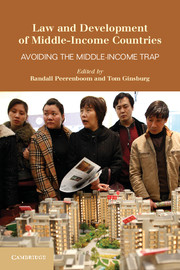Book contents
- Frontmatter
- Contents
- List of Contributors
- Acknowledgments
- 1 Law and Development in Middle-Income Countries
- Part I The Politics of Development in Middle-Income Countries
- Part II Middle-Income Countries in a Globalized Economy
- Part III Good Governance and the Rule of Law in Middle-Income Countries
- 7 Law and Development in Central and Eastern Europe
- 8 Judicial Intervention in Civic-Military Relations
- 9 The Prospects for Anticorruption Law in Middle-Income Countries
- 10 The Delivery of Justice in Middle-Income Countries
- Part IV Socioeconomic Challenges in Middle-Income Countries
- Part V International Donor Strategies for Middle-Income Countries
- Appendix Selected Country Data as of 2011
- Index
- References
8 - Judicial Intervention in Civic-Military Relations
Evidence from Colombia and Mexico
Published online by Cambridge University Press: 05 June 2014
- Frontmatter
- Contents
- List of Contributors
- Acknowledgments
- 1 Law and Development in Middle-Income Countries
- Part I The Politics of Development in Middle-Income Countries
- Part II Middle-Income Countries in a Globalized Economy
- Part III Good Governance and the Rule of Law in Middle-Income Countries
- 7 Law and Development in Central and Eastern Europe
- 8 Judicial Intervention in Civic-Military Relations
- 9 The Prospects for Anticorruption Law in Middle-Income Countries
- 10 The Delivery of Justice in Middle-Income Countries
- Part IV Socioeconomic Challenges in Middle-Income Countries
- Part V International Donor Strategies for Middle-Income Countries
- Appendix Selected Country Data as of 2011
- Index
- References
Summary
INTRODUCTION
Middle-income countries (MICs) suffer from state weakness, limited institutional capacity, political and social instability, violence, and organized crime. While these problems are also present in high-income countries (HICs), in MICs they often take center stage and sometimes threaten the very existence and viability of the state. In the words of Douglas North and colleagues, whereas HICs are “open access orders,” MICs are “limited access orders” in which the state does not yet have a secure monopoly on violence, and society organizes itself to control violence among the elite factions. A common feature of limited access orders is that political elites divide up control of the economy, each getting some share of the rents. As a consequence, several hurdles arise in the way to developing the institutional capacity that scholarship on MICs has signaled out as crucial for escaping the “Middle Income Trap.”
To build the required institutional capacity necessary to leave the trap and take MICs to the next level is challenging. It is no longer sufficient, as in low-income countries (LICs), to just throw people and money into factories: innovation and a more productive use of labor and capital become essential. This is reflected in the advices offered to leave the trap, which come down to maxims such as: “invest more heavily in R&D [research and development],” “specialize on selected growth niches where global excellence can be achieved,” or “create an active industrial policy.” In sharp contrast to the so-called Washington Consensus, which required a retreat of the state from the economy, policy recommendations for leaving the middle-income trap emphasize direct involvement and participation from the government and state institutions.
- Type
- Chapter
- Information
- Law and Development of Middle-Income CountriesAvoiding the Middle-Income Trap, pp. 156 - 178Publisher: Cambridge University PressPrint publication year: 2014

